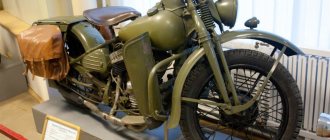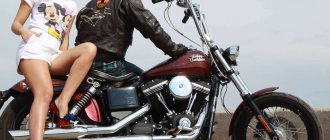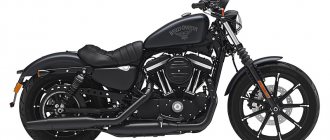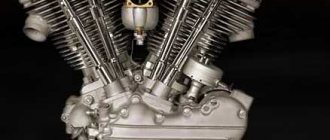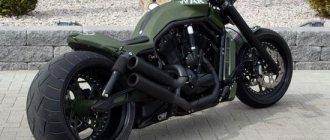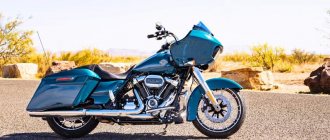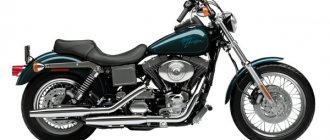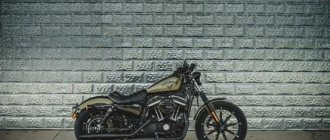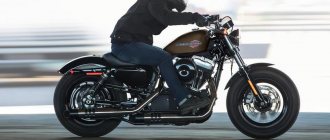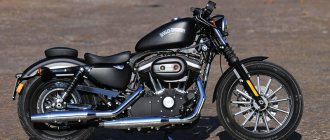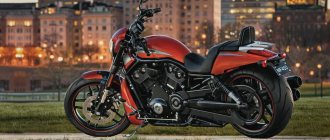photo: resurgencegear.co.nz
At the turn of the century, a new invention swept across America: the bicycle. This two-wheeled wonder allowed people to travel further and faster than ever before, and millions of people set out to explore the country by pedaling.
But that wasn't enough for 21-year-old William S. Harley and 20-year-old Arthur Davidson. In 1901, these two boys began their search, wondering how else they could make cycling easier.
“Their dream was to build a motorized bicycle that would allow people to travel reliably and as quickly as the technology of the time would allow.”
Realizing that they would need a skilled mechanic to achieve their dream, the duo enlisted the help of Arthur's brother, Walter Davidson, a railroad engineer whom they lured from his job in Kansas with the promise of a ride on their motorcycle. After arriving in Milwaukee, Walter discovered that he would have to help William and Arthur build their motorcycle before he could ride it. But he decided to stay anyway. Davidson's older brother William also offered to help.
Early years
One of the original founders, William Sylvester Harley of the Harley-Davidson Motor Company, was born on December 29, 1880 in Milwaukee, Wisconsin. Ambitious and business-savvy, Harley began his career at the age of 15 when he took a job in a bicycle factory.
Working with him was his childhood friend Arthur Davidson, who, like Harley, was obsessed with mechanics. The two also shared a deep interest in bicycles and were convinced that they could create a new kind of mechanized bicycle that would be easier to ride. Soon the two friends began experimenting with gasoline engines and testing them on their motorcycles.
Determined to make a better life for himself, Harley went to college, the first in his family, and eventually received a degree in mechanical engineering from the University of Wisconsin-Madison in 1907.
A trained draftsman, Harley returned to Milwaukee after college and began working with Davidson again to pursue his dream of building a motorized bicycle. They soon enlisted the help of Davidson's two older brothers, Walter, a railroad engineer, who provided the young company with an experienced mechanic, William, a tool room foreman.
Harley-Davidson Motor Company
In 1903, four men formed the Harley-Davidson Motor Company, which they operated from the Davidson family's small backyard barn. Harley's name was named the best billing because he is credited with the original idea for the motorcycle.
That first year the company produced three bicycles, which included a bicycle handle and pedals, as well as a single-cylinder motor.
Over the next few years, the company refined the motorcycle idea and attracted new business. By 1909, the company had its own factory, employing 35 people and producing over a thousand bicycles a year.
Behind much of the company's development was Harley, a perfectionist who spent hours creating the world's first twin-cylinder motorcycle engine. He did this in 1907, and in just a few years his patented V-Twin engine helped the company grow to 3,200 bicycles per year.
Over the next few decades, Harley-Davidson continued to experience significant growth in sales and popularity. They were also sought after by the US military, first ordered during the 1916 skirmish on the Mexico-US border and then in the global conflicts that followed. With the outbreak of World War I, between one-third and one-half of the company's output was devoted to the war effort. During World War II, the US military ordered more than 60,000 Harley-Davidson bicycles for the Allies to use overseas. Harley monitored transactions between the company and the War Department. After the war and into the 1950s, their motorcycles were the only American brand on the world market.
Until his death, Harley served as the company's chief engineer and treasurer. He was instrumental in the company's success and the introduction of new bicycles. He was also an avid racer and had a passion for testing his new motorcycles.
The history of the legendary Harley-Davidson motorcycle
The history of the Harley-Davidson brand is a story of professionalism, hard work, and self-belief. This is the story of a dream come true... And it began at the turn of the last century and the century before last, just as a huge number of other stories began, which, however, did not have the same victorious continuation.
Years passed, fierce competition served as the main factor in the natural selection of the best of the best. And less than half a century later, there was only one motorcycle brand left on the American market that conquered not only America but the whole world - Harley-Davidson.
1870 - Birth of William Davidson, Milwaukee, Wisconsin 1876 - Birth of Walter Davidson, Milwaukee, Wisconsin 1880 - Birth of William Harley, Milwaukee, Wisconsin 1881 - Birth of Arthur Davidson, Milwaukee, Wisconsin
About the wooden garage, its inhabitants and their creation:
1901-1903 - One day, two friends, Arthur and William, decided to attach an engine they had assembled to a bicycle. They are building their first motorcycle with a 116 cc engine. The motorcycle successfully passes “tests” on wooden velodromes of that time, intended for racing cyclists. For this purpose, an inconspicuous garage in the city of Milwaukee, located on Chestnut Street, was chosen. Currently, the head office of Harley-Davidson is located at this address. Soon the new unit was tested and passed it successfully. Thus began the era of the world's most famous motorcycle brand.
Today, the Harley-Davidson motorcycle is the dream of millions. And the very name HD makes the heart of everyone who has at least some connection to bike culture beat faster.
Without further ado, the creators simply wrote their surnames with a hyphen on the doors of the wooden garage and got to work. For a long time, when the fame of Harley-Davidson was thundering throughout the world, that same garage still remained the property of the owners. Moreover, the first assembly shop, and then the entire plant, was built around an inconspicuous plank building. Unfortunately, it did not survive to this day - it was accidentally destroyed by hired cleaners, mistaking it for old trash.
1904 - The first official Harley-Davidson dealer opens in Chicago.
1906 - construction of the company's first assembly shop with an area of about 250 sq.m. is completed on Chestnut Street. At this moment, Harley-Davidson has 6 workers on its staff. The company's first product catalog is published.
1907 - William Davidson joins the company. Harley-Davidson becomes a joint stock company (Harley-Davidson Motor Company). The stockholders are William Harley and the three Davidson brothers.
1908 - Walter Davidson wins first place in the 7th Annual Federation of American Motorcyclists Endurance and Reliability Contest. And three days later he sets a record for engine efficiency - travels 188 miles (302.5 km) on one gallon (3.78 liters) of gasoline. Perhaps impressed by these achievements, the Detroit mayor's office orders a large batch of Harley-Davidson motorcycles for police use.
The first victory in competitions on a motorcycle of his own production in 1908 was won personally by the president of the company, Walter Davidson. In several stages he scores a record number of points, and Harley-Davidson products become famous.
1909 - The company has always strived to win customers not with fluffy advertising, not with dubious promotions and not with cheap PR. Her signature has always been quality and unique style. The beginning of the twentieth century was marked by a number of innovations that gave the HD lineup several unique models. Each new Harley-Davidson motorcycle was equipped with the latest technology. The company's technologists were the first in the world to introduce such an innovation as water cooling of the engine. And to develop new models, the most powerful engines of that time were used, and the belt drive was replaced with a chain drive. For the first time, the legendary V-twin engine was created and put into mass production.
1911 - The single-cylinder "F" engine is invented and will power production HD motorcycles until 1929. The designation “F” comes from the fact that the intake valve ports are shaped like this letter of the English alphabet. The intake valve, as on modern engines, is located at the top of the engine, and the exhaust valve is located on the side.
1912 - Harley-Davidson begins shipping motorcycles to Japan. There are more than 200 official dealers of the company in the USA.
The first Harley-Davidson with a sidecar was designated J-18. It was equipped with the most powerful engine at that time and rear lights.
1914 - the first motorcycles with sidecars appear, equipped with a two-speed transmission. Belt drives are going out of fashion. The main disadvantages of belts of that time were that they often flew off the pulleys, stretched and broke when wet. The chain drive was an important innovation of the time.
1915 - HD motorcycles with a three-speed gearbox go on sale.
1917 - About a third of the company's products are purchased by the Ministry of Defense. To train military mechanics, Harley-Davidson opens a Quartermasters School; at the end of the First World War, it is renamed the Service School. Mechanics from the company's dealers undergo training and internships in production.
In 1917, Harley-Davidson was officially adopted by the US Army. In total, about 20,000 motorcycles were sent to the front.
1918 - almost half of the motorcycles produced were sold to the military and were actively used during combat operations in the First World War. After Germany signs surrender, Allied troops enter its territory. It is a widely known historical fact: after the surrender of Germany, the first American to cross its border - Corporal Holtz - was riding on nothing but a Harley.
1919 - The first Harley-Davidson sports model is introduced. It has a horizontally opposed engine with a volume of 600 cc. cm.
One of the divisions of Harley-Davidson is engaged in the design of exclusively sports motorcycle models. The company takes an active part in all competitions.
1920 - H-D becomes the largest motorcycle manufacturer in the world. The company has more than 2,000 official sales points in 67 countries. The company's racing team becomes the strongest in America. The team's mascot is a small pig, for this reason, the Harley Davidson motorcycle in the USA received the informal name “hog” - hog. This is what HD motorcycles are called to this day.
1925 - teardrop-shaped gas tanks begin to be installed on Harley-Davidson motorcycles, giving the company's products their own individual style. Before this, gas tanks had a flat top.
1928 - A two-cylinder engine was first installed on JD series motorcycles, thanks to which the maximum speed reached 150 km/h. From the same year, Harley-Davidson began equipping motorcycles with a front brake.
1929 - Model D with a V-twin engine with a volume of 730 cc was first released. A distinctive feature of the engine is a flat top. It would be installed on Harley-Davidson motorcycles for the next forty years, undergoing minor modifications.
The stock market crash marks the beginning of the Great Depression. Despite this, Harley-Davidson manages to sell 21,000 motorcycles. The company remains the strongest of several dozen motorcycle brands that emerged from 1900 to 1930. Only a few of them will live to see the fourth decade of the twentieth century.
1932 - This year the famous three-wheeled Servi-Car was released - a favorite vehicle for street hamburger sellers and police officers. The motorcycle was discontinued after 41 years.
1933 is the worst year in the company's history. Sales dropped to 4,000 motorcycles.
1935 - Alfred Child, an agent for the Harley-Davidson Motor Company in Asia, comes to the conclusion that exporting motorcycles to Japan is becoming unprofitable and convinces the company's management to sell a license to manufacture Harley-Davidson motorcycles to businessmen from the land of the rising sun. The license is acquired by the Sankyo Seiyakyo company and soon the first Harley clones with the name Rikuo, which translates as “king of the road,” come out of its workshops.
Selling the license to manufacture motorcycles to the Japanese company Sankyo Seiyakyo was a profitable decision, but after three decades, cheap Japanese-made motorcycles that filled the American market almost caused the collapse of Harley-Davidson.
1936 - start of production of the EL model, which was equipped with a 1,000 cc engine. see with overhead valves. Among motorcyclists, this model was called the 'Knucklehead' - “Iron Head” - due to the shape of the valve covers. In the same year, Harley Davidson released a 1.3-liter engine with a side exhaust valve.
1936 - WL model goes into production. William Davidson dies.
Harley-Davidson WL and WLA. “Liberator” was the name given to the Harley-Davidson WLA in Europe during World War II.
1941 - The United States enters World War II. The production of civilian motorcycles has almost completely stopped.
1942 - American troops in North Africa capture the first captured Zündapp and BMW. It turns out that Wehrmacht motorcycles are more suitable for heavy military service. Harley-Davidson and Indian companies produce about a thousand prototypes of motorcycles, the engine and drive shaft of which are copied from German ones. They were not widely used, but cost the American government an astronomical for that time $35,000 apiece. Walter Davidson dies.
1943 - William Harley dies
1945 - end of World War II. Over four years, 90,000 WLA model motorcycles were produced for the needs of the army.
1948 - Harley-Davidson engines of 1000 and 1200 cc are modernized. see with overhead valves. Aluminum cylinder blocks began to be installed on them.
Based on patents obtained by the US government as reparations after the surrender of Germany, Harley-Davidson released the Model S, later known as the Hammer.
1949 - production of the Hydra-Glide model began, on which a hydraulic fork was used for the first time.
1950 Arthur Davidson dies.
1952 - according to company technicians, Indian two-cylinder V-twin engines are superior in performance to Harley-Davidson engines. The company's response was the 735 cc. see side valve motor with block design. The crankcase and gearbox are located in one housing.
1953 - Indian bankruptcy. Harley-Davidson Motor Company, which turned 50 this year, remains the only motorcycle manufacturer in the United States.
1957 - the Harley Davidson Sportster with a 900 cc engine capacity is introduced to the public. see also the upper location of the valves.
Harley-Davidson Sportster is the most affordable and smallest motorcycle model.
The Harley Davidson Duo-Glide was the first motorcycle to feature hydraulic shock absorbers on both the front and rear wheels.
1958 - The Duo-Glide model appears, which features the world's first hydraulic rear suspension.
1960 - Harley-Davidson recognizes that the small class of motorcycles also have some market potential and releases its first and only scooter, the Topper. In the same year, the company buys 50 percent of the shares of the Italian aircraft and motorcycle manufacturer Aeromacchi.
1961 - the Sprint model appears, the appearance of which was developed by Aeromacchi designers. Thanks to its powerful engine and low center of gravity, it is gaining popularity among motorcycle racers.
1962 - Purchase of Tomahawk boat co. Fiberglass parts are beginning to be used in motorcycle designs.
1964 - The Servi-Car becomes the first Harley-Davidson motorcycle to feature an electric starter.
1965 - Electric starters begin to be installed on the Duo-Glide model, causing the model name to change to Electro-Glide
1966 - Complaints from motorcyclists that Harley-Davidson's engine was not powerful enough forced the company to modernize its 1000 and 1200 cc engines. The new valve cover was shaped very much like a shovel (shovel - in English), so the motorcycle with the updated engine began to be called “Shovelhead”. Over the next 20 years, this type of engine became the main one on Harley-Davidson motorcycles.
1969 - Despite the fact that Harley-Davidson Motor Company shares are traded on the stock exchange, there are not so many owners of these securities. This year, the main shareholders, under the threat of the so-called “Japanese Invasion,” as the planned entry of the Honda CB750 Four motorcycle into the American market was called, are selling a controlling stake in Harley-Davidson to American Machine and Foundry Co. At that time, AMF, although engaged in business in various industries, was generally known as a manufacturer of bowling balls. Under the new owner, the quality of the motorcycles produced dropped sharply.
1971 - By combining the steering wheel and front wheel of the XL model with the frame and engine of the FL model, the company's designers create the first cruiser - the FX 1200 Super Glide.
1973 - A new assembly plant for Harley-Davidson Motor Company opens in Pennsylvania.
1977 - the FXS Low Rider and 1977 XLCR models appeared - the latter motorcycle is now the object of hunting for collectors, although in 1977 almost no one wanted to buy it. A total of 3,100 1977 XLCR motorcycles were produced and production had to be curtailed the following year. Previously unused 1977 XLCRs could be found in dealer showrooms until the early 80s.
Harley-Davidson XLCR and Harley-Davidson FXEF are symbols of one of the most difficult periods in the life of the company.
1979 - Production of the FXEF model began. This motorcycle received the unofficial name “Fat Bob” due to its two gas tanks and “blown” fenders.
1980 - FLT, FXB Sturgis models with a 1300 cc engine were launched. see and FXWB Wide Glide.
Belt drive is coming back into fashion. Some models use a Kevlar belt instead of a chain.
1981 - Years of ineffective management led to the fact that Harley-Davidson lost the trust of customers, and profits fell sharply. When several investors, led by Vaughn Beals, proposed that AMF management buy out Harley-Davidson Motor Company for $75 million, the deal was approved. After this, the Harley-Davidson company is doing much better. Beals imposes strict quality standards on production sites and funds new developments.
1982 - FXR/FXRS Super Glide II released.
The company's management continues to work to reduce production costs and improve the quality of motorcycles.
1984 - a new model engine, the 1340cc V2 Evolution, is installed on five models of Harley Davidson motorcycles. It is characterized by high reliability and low oil consumption.
1987 - the company conducts an IPO. Harley-Davidson Motor Company's ticker symbol on the New York Stock Exchange is designated HOG. Experts note that Harley Davidson motorcycles are capable of adequately competing with Japanese motorcycles even without the government applying protective duties.
1990 - production of the FLSTF Fat Boy model began.
1991 - The first motorcycle in the Dyna model line, the FXDB Dyna Glide Sturgis, was introduced to the public.
1992 - Harley-Davidson becomes the first company to use drive belts on all motorcycle models. They are more durable than chains and require no maintenance.
1995 - A fuel injection system begins to be installed on all new motorcycle engines.
1996 - A workshop for the production of Harley-Davidson spare parts and components opens in Wisconsin, with an area of 23,000 square meters. m.
In the mid-90s, Harley-Davidson Motor Company began to actively conquer new markets and expand existing production.
1997 - The Harley-Davidson design bureau opens in Milwaukee. Production of the FL engine begins at the Menomonee Falls plant acquired by the company. Sportster production moves to a new manufacturing facility in Kansas City.
1998 - the company opens its first branch abroad - a factory in the Brazilian city of Manaus.
1999 - The new Twin Cam 88 engine begins to be installed on motorcycles of the Touring and Dyna model lines.
2000 - Despite tens of thousands of dollars spent on legal fees, Harley-Davidson Motor Co. abandons attempts to patent the characteristic “Harley” sound of the engine.
2001 - The VRSCA V-Rod is introduced. The engine, in the creation of which Porche specialists took part, is equipped with an injector, a liquid cooling system and an overhead camshaft.
2003 - 100th anniversary of Harley-Davidson. About 250,000 guests come to Milwaukee for special events.
2006 - A 6-speed gearbox is installed on Dyna motorcycles for the new model year. The company's management announces the start of construction of the Harley-Davidson Museum.
2008 - The opening of the Harley-Davidson Museum coincides with the 105th anniversary of the company.
Purchase of MV Agusta for $109 million in order to more successfully promote Harley-Davidson products on the European market.
The XR1200 model, developed specifically for Europe, has been introduced. Subsequently, it is successfully sold throughout the world.
2009 - the company is headed by Keith Wandell, since 1981 this is the first time that shareholders have appointed a top manager who was not previously associated with Harley-Davidson Motor Company. Due to the economic crisis, the MV Agusta division has to be put up for sale. The company's profit compared to the previous year is reduced by 84%. Harley-Davidson's plan to enter the fast-growing Indian market has been unveiled.
2013 - As part of the Rushmore project, Harley-Davidson updated the platform of touring motorcycles, making them more comfortable.
In June 2014, the presentation of the first electric motorcycle, LiveWire, took place.
Harley-Davidson - To be continued...
Source
